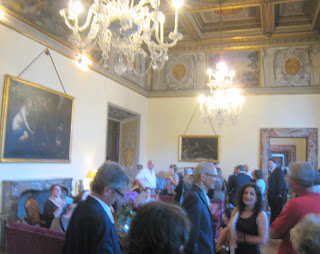That’s mostly true, but not entirely. The building that houses Eataly was
constructed with public funds. It opened
in 1989/90 as the Air Terminal Ostiense, first to handle the traffic from the
1990 World Cup, then as the place that would connect tourists and others
arriving at Rome’s far-away Fiumicino Airport with the city of Rome. Designed by Spanish architect Julio Lafuente in
the grand, open, monumental style of Penn Station (now defunct) by way of the
Baths of Caracalla, the postmodern structure fell on bad times from the
beginning. Travelers had difficulty
finding taxis, carting their luggage over (or under) the broad set of tracks to
the regular railway station, or getting to the Metro; everything was close as
the crow flies, but humans with luggage could only wish they had wings. It was not long before the station was
abandoned for the purposes of the Fiumicino trade, and for at least a decade it
remained empty. The more recent
chronology is a bit murky: in 2009 and 2010 the Air Terminal was used,
unofficially, to house homeless Afghani refugees; in the former year it was
purchased by the financiers of Eataly. (Air Terminal Ostiense gets a brief mention in Rome the Second Time (the book) at page 68.)
While the powerful and yet playful exterior of Lafuente’s
Air Terminal remains as he designed it, little—indeed, nothing—remains of the
interior. The enormous, open halls of
the original have been filled in, 3 floors added.
The spectacle remains, but it is of a
different sort than Lafuente had in mind: rather than the spectacle of wondrous
space, we have the spectacle of the 21st century department store,
the spectacle of goods and services, of fashion and design, or products and
packaging, of color and choice.
This is the spectacle of the
worldwide furnishing giant IKEA, of an engaging, accessible, and sensible
capitalism, there to make money, yes, but also to bring us what we need, what
is best for us.
Eataly, of course, is all about food. But not just any food, and not just any
Italian food. Eataly comes with a
9-point Manifesto (perhaps 10 would seem too contrived). Among its points: food unites people across
lines of social class; high quality food improves one’s general quality of
life; consumers should know the story, the history, behind the foods they
consume; and high quality foods should be available at affordable prices
(indeed, a recent advertisement promises, “At Eataly high quality costs half.”) There’s a lot of emphasis on the importance
of “what we put inside our bodies,” as opposed to the things outside, and lots
of talk about their “passion” for providing
people with good food and how vital it is that people be “passionate”
about what they eat. Substitute “home
furnishings” for “food” and you’ve pretty much got IKEA.
| Coffee bar |
| Fruits and vegetables, not a priority |
There’s lots to think about here. We know there’s some truth in the claim that the
tensions of social class can melt away in the pleasures of a good meal. But one of Eataly’s markets is the very
affluent consumer. At least one of its
fourth-floor restaurants caters to the very rich, and posters announce series
of 12 wine-tastings for 500 Euro. It’s
hard to disagree with the idea that what we put in our bodies is important. But one of Eataly’s many food outlets sells
pizza and another specializes in “fritti”—that is, deep fried foods, shrimp,
calamari and meatballs (delicious – we know, we tried them) and other
treats—that are very Roman but would seem low on the nutritional scale. Most of the wines sold at Eataly contain
suphites. There’s a huge section devoted
to the fatty meats—ham, mortadella, sausage—that Italians devour. And
the fruits and vegetables department, where the produce is displayed under canvas tents designed to suggest an old-fashioned market, is tiny.
| Lots of choice |
We
can’t really speak to the issue of whether the food available at Eataly is of
“high quality,” or of higher quality than one can get elsewhere in Rome (that,
after all, would be a sensible standard).
Moreover, how would one prove such a claim? Mayor Gianni Alemanno, the conservative
ex-thug not known for his cultured sensibilities, had no such doubts. Eataly, he announced, is “launching a model
where one says no to consumerism, but yes to the quality of what one
consumes.”
| Eataly's shopping carts and fashionably-dressed shopper |
We have one more concern, possibly the most significant for
Rome, and it emerges directly from the Eataly’s advertising. “Already,” says the company, “many Romans
have taken to doing all their grocery shopping at Eataly” (hanno presso a fare la spesa completa da Eataly). If we thought that say, half of Eataly’s
sales would be to tourists and foreigners, that would be one thing. But we found only one sign of any kind in
English, the common language of Rome tourism; everything’s in Italian—a good
indication that that’s the key market.
If most of those customers are Romans, we can’t help but wonder what’s
going to happen to the local meat markets, salumerie (essentially delis), and
neighborhood markets that are now just holding their own against a growing
number of small, chain grocers. At
bottom, Eataly is just a “big box” store—an attractive and enticing one to be
sure—ready, like all big-box stores everywhere, to destroy the little
guys. That’s what they do.
| Eataly as spectacle |
| Supervisor (left) and employees try to figure out how to serve us our fritti. Opening day jitters |
Bill
We point out that Eataly was in 8 other cities in Italy
before coming to Rome, and that in addition to its highly successful New York
City operation, it has 7, soon to be 9 locations in Tokyo. Coming soon: Chicago, Los Angeles.
 |
| How the Air Terminal Ostiense interior should have looked |
| Some sense of Lafuente's volume remains |

















